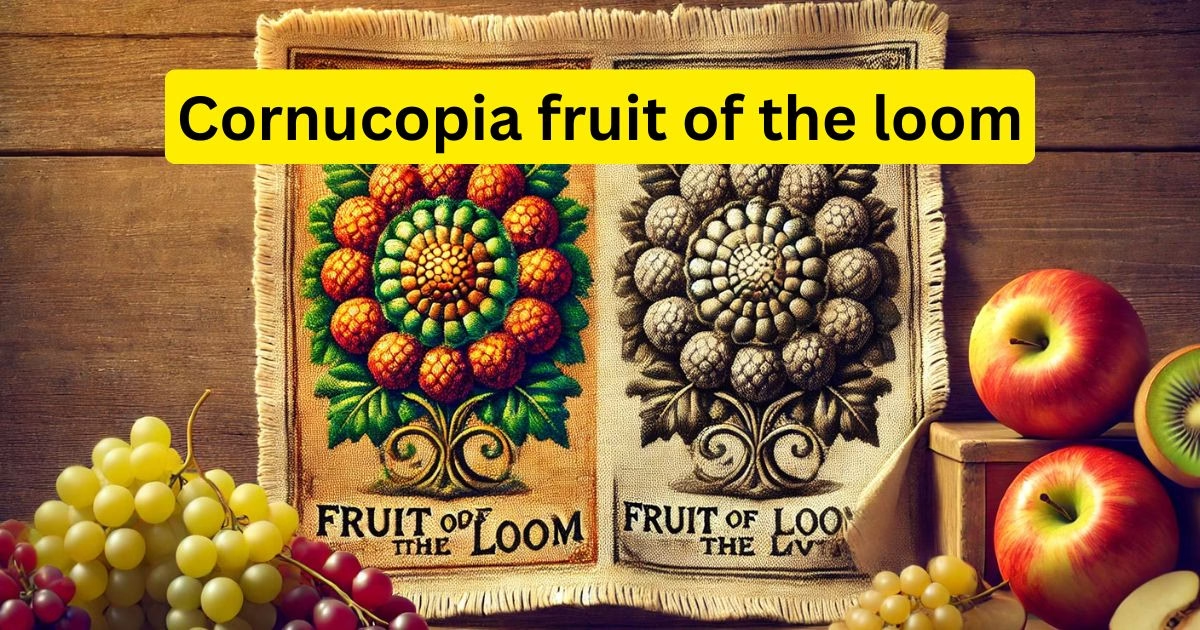Over the years, the cornucopia fruit of the loom logo has sparked much debate, primarily due to a widespread belief that it once featured a cornucopia. This common misconception, driven by the Mandela Effect, has led many to recall the logo as including a horn-shaped basket filled with fruit. However, the truth is quite different, and in this blog post, we will debunk this myth by exploring the history of the Fruit of the Loom logo, the cultural impact of such branding misconceptions, and why the cornucopia was never a part of the iconic design.
The Origin of the Fruit of the Loom Logo
The Fruit of the Loom logo has been a recognizable symbol for over 150 years, depicting a cluster of fruits—typically grapes, apples, and currants. The brand has long been associated with high-quality textiles, and its logo reflects a sense of abundance and vitality. However, despite the common association with the cornucopia, the actual Fruit of the Loom branding has always been simple, clean, and devoid of such a basket. This logo was created to embody the rich, natural goodness that the brand aimed to represent, without the need for a horn-shaped basket. As it turns out, the fruit of the loom logo design has always been focused on the fruits themselves, making it easy to see how a misunderstanding of the imagery could have led to the misconception of a cornucopia being part of the logo.
The Mandela Effect: Cornucopia in the Fruit of the Loom Logo
The phenomenon known as the Mandela Effect refers to a situation in which a large group of people remember something one way, but reality tells a different story. In the case of the cornucopia fruit of the loom logo, many individuals recall seeing a cornucopia in the background of the fruit cluster, perhaps due to cultural associations of the cornucopia with abundance and harvest. However, the reality is that the cornucopia effect in branding has no basis in the Fruit of the Loom logo history. This misconception, like many Mandela Effects, is part of a wider cultural memory distortion, where people collectively misremember details about well-known logos and symbols.
Debunking the Cornucopia Myth
Upon reviewing past Fruit of the Loom marketing materials, advertisements, and the official logo, it’s clear that no cornucopia has ever been part of the design. The absence of the cornucopia in advertising is evident in nearly every documented use of the logo, and there are no historical examples that feature a cornucopia. The myth likely emerged from a combination of misinterpretations and the widespread use of the cornucopia as a symbol of abundance, which is often seen in imagery related to harvests or festive occasions. The truth behind logo myths like this one highlights how easily visual memories can become distorted and how collective memories can lead to widely held but incorrect beliefs.
The Role of Branding and Iconography in Memory
Branding plays a significant role in shaping consumer memory, often through powerful visual cues. Logos, colors, and symbols become ingrained in the public’s perception, influencing brand recognition and loyalty. In the case of Fruit of the Loom, the simplicity of the fruit logo brands allowed for easy recall. However, cultural and psychological factors, such as the human tendency to associate abundance with a cornucopia, may have contributed to the distortion of the original logo. Iconography in branding is often more influential than people realize, and visual memory can easily become influenced by external associations, leading to mistaken logo features like the cornucopia myth.
Also Read: How to Grow and Hunt for Your Own Food: Master Self-Sufficient Living
The Cultural Impact of the Cornucopia in Branding
The cornucopia, or “horn of plenty,” has long been associated with themes of abundance, harvest, and the natural world. This cultural symbol is frequently used in advertising to convey ideas of richness, generosity, and plenty. Because of these associations, the cornucopia imagery in logos has become so deeply ingrained in our collective cultural memory that many people mistakenly believe it was part of the Fruit of the Loom logo. The prevalence of such symbols in holiday marketing, especially around Thanksgiving and harvest festivals, may have also contributed to the confusion. The cultural myths and logos that emerge from these kinds of misunderstandings illustrate how our minds can fill in the gaps with familiar symbols, even if they were never part of the original design.
Final Thoughts
The cornucopia fruit of the loom myth has endured for years, largely due to the power of collective memory and the influence of visual branding. While the Fruit of the Loom logo has never featured a cornucopia, the misconception speaks to the ways in which branding and symbolism can shape how we remember logos. As we continue to navigate the world of branding and marketing, it’s important to remember that our memories are not always as accurate as we think. The truth behind logo myths, such as the cornucopia in Fruit of the Loom, serves as a reminder of how branding, memory, and culture intertwine to create powerful, though sometimes mistaken, visual impressions.

